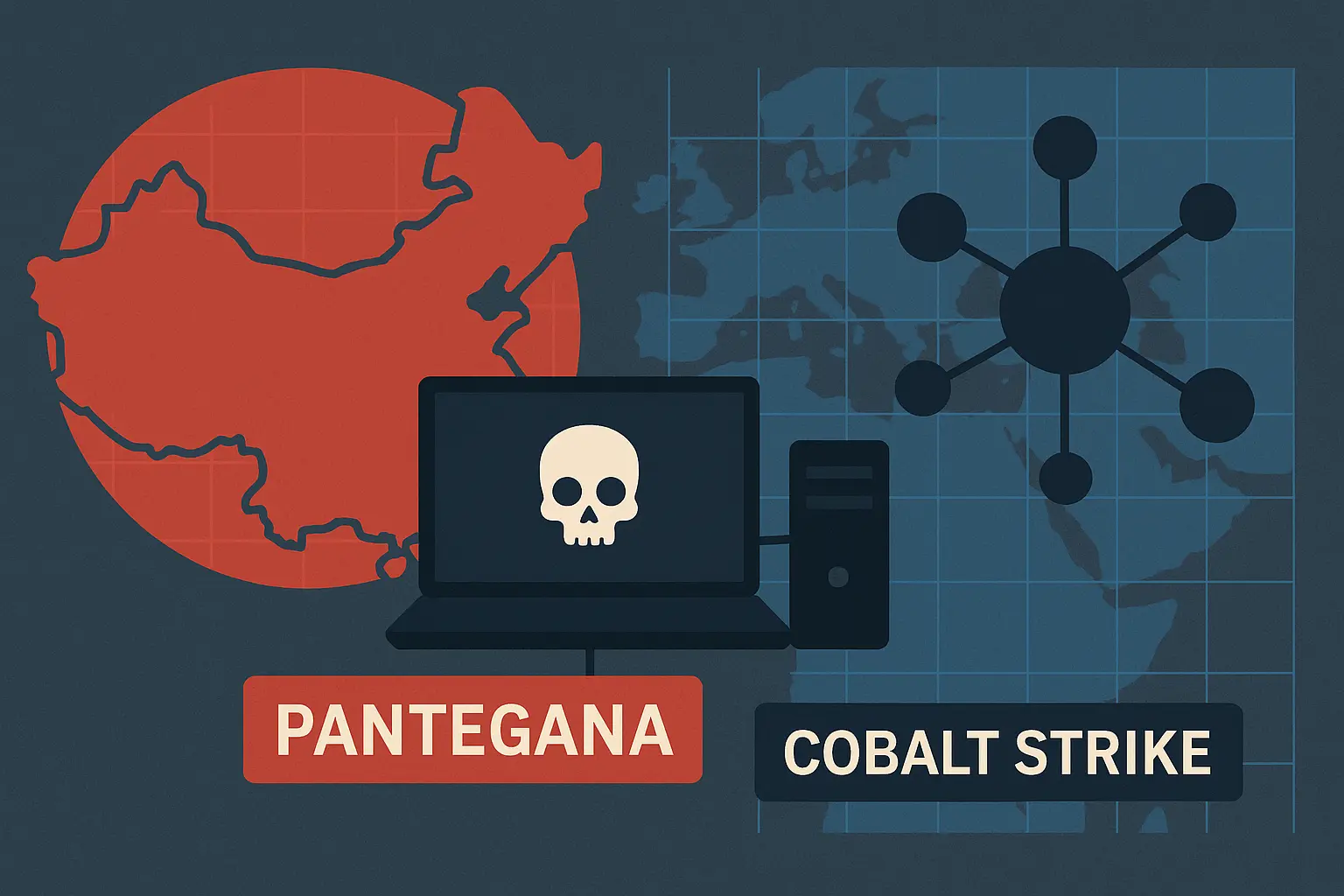Over the past year, a Chinese-linked threat actor known as RedNovember has emerged as a significant player in the global cyber-espionage landscape. Their operations have targeted governments, defense contractors, law firms, and critical infrastructure providers across multiple regions. What sets RedNovember apart is its pragmatic playbook: exploiting unpatched internet-facing devices to gain entry, deploying lightweight loaders like Pantegana for stealthy persistence, and then escalating to powerful frameworks such as Cobalt Strike for deeper operations.

This blend of commodity malware and advanced red-team tooling is deliberate. By leaning on open-source loaders and widely used frameworks, RedNovember lowers its costs, complicates attribution, and achieves operational flexibility. For enterprise defenders, the implication is clear: perimeter appliances can no longer be treated as static, low-risk assets. When compromised, they become gateways for sophisticated espionage campaigns that are difficult to detect and harder to eradicate. In the following sections, we’ll dissect RedNovember’s tradecraft step by step, from initial perimeter breaches through their use of Pantegana and Cobalt Strike , and examine how organizations can detect, disrupt, and defend against this evolving adversary.
Initial Access — Perimeter Breaches
RedNovember’s most reliable entry vector is compromised internet-facing edge devices , VPN concentrators, firewalls, load balancers, VDI gateways, and web login portals. Rather than rely primarily on phishing, the actor focuses on appliances that, when breached, provide privileged access and broad lateral opportunity inside target networks. Why the edge is attractive?
High payoff: a single appliance compromise can expose administrative sessions, cached credentials, and management planes that touch many internal systems.
Visibility gaps: appliance telemetry is often sparse or not forwarded to SOC tooling, giving attackers extended dwell time.
Fast exploitation: RedNovember moves quickly after public exploit proof-of-concept code appears, scanning widely and weaponizing vulnerable instances.
RedNovember’s exploitation cycle follows a predictable but effective sequence. The actors begin by scanning broadly to discover exposed management interfaces and fingerprint device banners to identify vulnerable firmware or software versions. When a suitable public-facing flaw is found, they quickly weaponize it—often an RCE or authentication bypass—to gain code execution on the appliance. From there they drop a lightweight foothold, such as a webshell or a small Go-based loader, on the compromised device or the first reachable internal host. With that foothold in place they pivot into the environment, harvest cached credentials and active sessions, and abuse appliance tunnels or administrative channels to move deeper into the network toward high-value targets.
High-signal detection opportunities
There are several high-signal indicators that commonly reveal appliance compromise. Pay attention to unexpected outbound connections originating from appliance management IPs, particularly when those connections go to low-reputation or previously unseen hosts. Likewise, administrative logins that occur outside normal business hours or from unusual geographies especially when followed by configuration exports or file uploads are strong signs of malicious activity. Other red flags include exploit-style HTTP requests hitting management endpoints (odd content types, unusually long POST bodies, or anomalous URI patterns), sudden firmware uploads or unexplained configuration changes, and the creation of new accounts on management consoles. Finally, a burst of authentication failures against public portals that is followed by a successful access should be treated as an urgent investigation lead.
Immediate mitigation (operational checklist)
- Patch public-facing appliances promptly or apply vendor virtual patches and WAF rules if patching is delayed.
- Restrict management interfaces to allow-listed IPs and require administration over jump hosts.
- Enforce MFA for all administrative and remote access paths.
- Forward appliance admin and web logs to the SIEM and enable NetFlow or NDR monitoring for appliance traffic.
- Pre-authorize an IR playbook for appliance compromise that includes config preservation, memory capture where possible, and rapid credential rotation.
Longer-term posture changes
- Treat the edge as high-risk and instrument it accordingly.
- Move toward zero-trust and microsegmentation so appliance compromise cannot freely bridge into sensitive zones.
- Run regular purple-team exercises that simulate appliance exploitation and validate detection and containment workflows.
Pantegana Loader – The First Stage
Once RedNovember has breached the perimeter, they rely on Pantegana, a lightweight loader written in Go, to establish their first presence inside the network. While this tool is publicly available and relatively simple compared to custom state-developed implants, it has proven highly effective in espionage campaigns. The strength of Pantegana lies in its portability and ease of deployment. Being cross-platform, it can be compiled for multiple operating systems, making it a flexible option for attackers who want to scale quickly across diverse targets.
The loader’s role is not to maintain long-term control but to provide a bridge. It is typically dropped on the compromised appliance or on the first reachable host behind it, where it blends into environments that often lack robust monitoring. Once executed, Pantegana reaches out to attacker-controlled infrastructure, downloads secondary payloads, and prepares the system for the next stage of compromise. The most common follow-up is a Cobalt Strike beacon, which transforms a modest foothold into a full-featured espionage platform. Pantegana’s success stems from its deliberate simplicity. Its code is lightly obfuscated, enough to slip past basic antivirus checks but not so complex that it draws attention as a bespoke, high-value implant. It can perform process injection, giving it cover by hiding within legitimate system processes, and it uses standard network protocols that blend in with normal traffic. Because the tool is available in the wild, defenders cannot easily tie its use directly to a specific actor, which complicates attribution and allows groups like RedNovember to operate with less scrutiny.
For defenders, spotting Pantegana requires vigilance across multiple layers. New Go-compiled binaries appearing in unusual locations should raise suspicion, particularly in environments where software deployment is tightly controlled. Equally telling are benign processes suddenly generating outbound network connections to domains they have never contacted before, especially when these connections recur at regular intervals. In-memory analysis can also uncover Pantegana’s injected payloads and provide critical evidence of compromise.
The loader itself may not be the most advanced tool in RedNovember’s arsenal, but it is the linchpin that makes their playbook work. Without early detection at this stage, organizations risk allowing a commodity loader to pave the way for one of the most flexible and dangerous frameworks in the attacker’s toolkit: Cobalt Strike.
Transition to Cobalt Strike — Post-Exploitation Tactics
After establishing a foothold with Pantegana, RedNovember commonly escalates to a more capable and flexible post-exploit framework: Cobalt Strike. The shift from a lightweight Go loader into a mature red-team platform is deliberate. Pantegana provides a fast, low-noise entry and the means to stage a powerful toolset that enables long-range reconnaissance, credential theft, lateral movement, and data staging for exfiltration.
Handoff mechanics: how the loader pivots into Cobalt Strike
- Staged retrieval: Pantegana frequently fetches a Cobalt Strike beacon as a second-stage payload. That retrieval happens over standard protocols (HTTPS being most common) to blend with legitimate traffic. Teams should expect staged stager→beacon downloads from Pantegana-infected hosts.
- Process injection and reflective loading: once the beacon is retrieved, operators typically use in-memory reflective loading or process injection into trusted host processes (eg. svchost.exe, explorer.exe, lsass.exe in rare cases) to avoid writing persistent beacon binaries to disk. This minimizes forensic footprints and complicates detection by signature-based AV.
- Stageless vs staged beacons: sometimes actors use stageless beacons packed into a single binary to reduce network requests; other times they use a small stager that pulls the stage to reduce the on-disk artifact surface. Expect both patterns.
- Jump hosts and chaining: in many cases the initial appliance pivot is used to place Pantegana on a jump host or VPN gateway, and from there the Cobalt Strike beacon is staged onto an internal workstation or server with richer network access.
Typical Cobalt Strike behaviors observed in these campaigns
- Malleable C2 profiles: RedNovember customizes C2 traffic to mimic legitimate web traffic (custom User-Agents, staged GET/POST patterns, HTTP header morphing). Malleable profiles introduce variability in beacon framing, domain pathing, and encryption wrappers.
- Beacon jitter and sleep strategies: to evade network anomaly detection, operators configure beacons with randomized sleep/jitter intervals, sporadic check-ins, and low-bandwidth callbacks during reconnaissance phases, increasing frequency only during active collection or lateral ops.
- Use of proxies and residential IPs: to obfuscate true infrastructure, threat operators frequently route C2 through compromised hosts, cloud instances in diverse geographies, or residential IP sets. This complicates IP-based blocking and attribution.
- Living off the land combined with Cobalt Strike tooling: rather than rely solely on built-in Cobalt Strike features, operators favor hybrid workflows: built-in beacon tasks (screenshot, keylogging, upload/download) alongside Windows native tools for credential access and lateral movement.
Credential theft and privilege escalation
- Memory scraping (Mimikatz and variants): Cobalt Strike sessions are commonly used to run credential dumping tools against lsass.exe or to perform domain controller interrogation for cached credentials. Captured NTLM hashes or cleartext credentials are then reused for lateral movement.
- DCSync and domain abuse: when domain admin credentials or DCSync capabilities are attainable, RedNovember will attempt to replicate credential data directly from domain controllers to create durable, high-privilege access.
- Kerberoasting and ticket theft: where practical, the actor will request service tickets and perform offline cracking to escalate privileges without triggering noisy AD authentication patterns.
- Credential reuse and lateral hopping: harvested credentials are used with native remote execution tools (PsExec, WMI/WinRM, RDP) or via Cobalt Strike’s built-in psexec-like mechanisms to move laterally.
Lateral movement and persistence techniques
- Remote execution tools — PsExec, WMI (wmic /wmiexec), and WinRM are commonly used for lateral execution; defenders should expect anomalous execution sequences invoking these tools from hosts that do not normally perform admin tasks.
- Service creation and scheduled tasks: operators will create ephemeral services or scheduled tasks to maintain access across reboots. These artifacts are often removed after use, so timeline correlation is critical.
- DLL sideloading and binary planting: in some environments, DLL sideloading against signed binaries or planting of malicious DLLs in application directories allows stealthy persistence that looks benign to AV and signing checks.
- Credential caching and token theft: use of RunAs, creation of local admin accounts, and harvesting of cached credentials on endpoints are all straightforward techniques in the actor’s toolbox.
Data collection and staging for exfiltration
- Targeted collection: RedNovember’s operators are selective: they prioritize repositories, email archives, SharePoint/OneDrive synchronizations, and sensitive document stores rather than mass data grabs.
- Compression and encryption: collected data is often compressed and encrypted locally before exfiltration to reduce detection via content inspection.
- Covert exfiltration channels: exfil is often blended into legitimate protocols (HTTPS uploads to compromised cloud storage, DNS tunneling for small payloads, or multi-stage relays through victim infrastructure).
Operational security and evasion
- Cleanup and anti-forensics: on discovery of activity, operators frequently attempt to remove event logs, clear shell histories, and delete temporary artifacts to hamper IR.
- Use of ephemeral infrastructure: short lived C2 hosts and frequent domain rotation minimize long-term trail persistence.
- Leveraging legitimate admin channels: by using legitimate management tools and administrative credentials, their activity can look like authorized administrative work, increasing dwell time.
Incident response priorities upon detecting Cobalt Strike activity
If a Cobalt Strike beacon or related activity is detected, immediate actions should follow a triage-first IR approach:
- Isolate the affected endpoints: but avoid severing network connections that would destroy volatile evidence needed for memory analysis unless continuing operation poses an imminent risk.
- Acquire volatile memory and critical logs: capture process memory from suspected hosts (to recover beacon configuration, malleable profile snippets, decrypted C2 metadata, and possible credentials). Collect Sysmon, proxy, and firewall logs around the suspected timeframe.
- Identify lateral movement and pivot points: enumerate recent RDP/WMI/PsExec activity and examine domain logs for suspicious service ticket requests or replication events.
- Rotate credentials and audit privileged accounts: assume credential compromise and rotate passwords and keys for accounts that touched infected endpoints; disable compromised accounts until validated.
- Hunt for persistence: search for scheduled tasks, new services, unusual run keys, and implanted DLLs or scripts in startup folders.
- Map and contain C2 infrastructure: track C2 domains and sinks; if tactical, sinkhole or block known C2s network-wide while preserving evidence.
- Engage specialized forensic support: where DCSync or domain controller involvement is suspected, bring in experienced AD forensic analysts to validate DC integrity and root cause.
Detection signals defenders should instrument for
- Anomalous parent/child process relationships: benign system processes spawning network connections or PowerShell with encoded command lines.
- Unusual in-memory modules: processes with suspicious injected DLLs or threads that do network I/O without corresponding signed modules.
- Beacons with irregular but periodic traffic: low-volume, regular callbacks to external hosts that do not match known application patterns.
- Unusual use of remote admin tools: endpoints invoking PsExec/WMI/WinRM from systems that do not commonly perform administrative tasks.
- Memory artifacts indicating Cobalt Strike: strings, mutexes, or decrypted beacon profiles recovered from RAM that align with known Cobalt Strike constructs.
Mapping RedNovember’s Playbook to MITRE ATT&CK
Understanding RedNovember through the MITRE ATT&CK lens turns narrative into actionable control points. The mapping below highlights the high-impact techniques RedNovember uses across the kill chain and shows where defenders can insert detection and disruption controls.
Initial Access
T1190 Exploit Public-Facing Application: Exploitation of VPNs, firewalls, load balancers, and web login portals.
T1078 Valid Accounts: Abuse of compromised admin credentials recovered from the appliance or credential stores.
Execution
T1059 Command and Scripting Interpreter: Use of PowerShell, WMI, and cmd to stage tools or run scripts.
T1204 User Execution: In some cases, social engineering or malicious email attachments are secondary access vectors.
Persistence
T1053 Scheduled Task/Job: Temporary scheduled tasks for persistence and execution.
T1543 Create or Modify System Process: Service creation and DLL sideloading for persistence.
T1098 Account Manipulation: Creation of local accounts or modification of existing accounts.
Privilege Escalation
T1068 Exploitation for Privilege Escalation: Targeted exploits on internal hosts.
T1003 Credential Dumping: Memory scraping and credential harvesting using tools such as Mimikatz or built-in Windows APIs.
Defense Evasion
T1036 Masquerading: Process and binary concealment, naming to look benign.
T1055 Process Injection: Reflective loading and injection into trusted processes.
T1070 Indicator Removal on Host: Log clearing and artifact cleanup.
Credential Access
T1110 Brute Force: Password spraying against login portals and VPNs.
T1555 Credentials from Password Stores: Harvesting of cached credentials and configuration secrets on appliances.
Discovery
T1083 File and Directory Discovery: Targeting data stores and document locations.
T1018 Remote System Discovery: Scanning internal networks for hosts and services.
Lateral Movement
T1021 Remote Services: RDP, WinRM, and PsExec-based lateral execution.
T1570 Lateral Tool Transfer: Moving tools and payloads between hosts.
Collection
T1119 Automated Collection: Scripting to gather email, document stores, and OneDrive/SharePoint content.
T1123 Audio Capture and T1113 Screen Capture: Opportunistic data collection during sessions.
Command and Control
T1071 Application Layer Protocol: HTTPS-based beaconing with malleable profiles.
T1095 Non Application Layer Protocol: DNS tunneling for small data stealth exfil.
Exfiltration
T1041 Exfiltration Over C2 Channel: Staged, encrypted uploads to attacker-controlled endpoints or cloud storage.
T1020 Automated Exfiltration: Compressed, encrypted staging of key data prior to transfer.
Detection and Hunting Guidance
Detecting RedNovember requires stitching together endpoint, network, identity, and appliance signals. Start with a small suspicion — an unusual outbound connection, an odd admin login, or a new binary on a jump host — and follow that thread across logs and memory captures until you build a clear picture. Treat jump hosts, VPN concentrators, and management appliances as high-fidelity choke points: when instrumented well they yield early, high-value indicators of compromise.
Endpoint telemetry is foundational because process lineage reveals intent: a legitimate process spawning an unsigned binary or an obfuscated PowerShell command is more telling than an external IP alone. Memory capture must be part of triage; RedNovember favors in-memory loading and process injection, and RAM often contains decrypted beacon strings, malleable profile fragments, and ephemeral credentials that don’t exist on disk. Network telemetry complements endpoint signals by exposing beaconing and covert exfiltration — look for periodic, low-bandwidth HTTPS callbacks, unusual POST/GET sequences, and outbound sessions from appliance management IPs.
Key hunting primitives (translate these into SIEM/EDR queries)
- Periodic outbound callbacks: find hosts with low-volume, regular HTTPS callbacks to newly observed domains or IPs over 24–72 hours; pivot to process lineage to identify the originating process.
- Suspicious parent/child chains: alert on system processes (e.g., explorer, svchost) spawning PowerShell, cmd, or unknown binaries, especially when coupled with WriteProcessMemory / CreateRemoteThread behaviors.
- Appliance management anomalies: correlate admin logins to appliance consoles with subsequent outbound connections or config exports; treat appliance-initiated external sessions as high priority.
- Data staging detection: search for recent compressed archives placed in temporary folders or moved to share paths shortly before external transfers — targeted staging looks different from opportunistic bulk grabs.
Operational tips: baseline normal per-role behavior so deviations are meaningful, enrich outbound indicators with domain age and ASN data to reduce false positives, and instrument jump hosts with enhanced logging retained for at least 90 days. Make memory-first capture an automated, early step in IR playbooks and build quick enrichment runbooks (WHOIS, passive DNS, ASN) so analysts can score and prioritize fast.
Hunt iteratively: start broad to generate candidates, then narrow with process lineage, identity context, and memory artifacts. Regular purple-team exercises simulating appliance compromise → Pantegana → Cobalt Strike will help tune detections and reduce dwell time.
Strategic Implications for CIOs and CISOs
RedNovember’s operations highlight a broader evolution in cyber-espionage tradecraft. Their reliance on perimeter appliance exploitation, lightweight loaders, and commercial red-team frameworks shows that sophisticated actors no longer need to rely solely on bespoke malware to achieve strategic outcomes. For technology leaders, the implications stretch beyond technical defenses and into governance, risk management, and operational readiness.
Enterprises can no longer treat edge appliances as “infrastructure plumbing” that sits outside of standard patching and monitoring cycles. These devices are now prime targets, often holding privileged credentials and acting as gateways to critical internal systems. If they are not treated as high-risk assets, organizations risk leaving the very doors RedNovember seeks wide open. CIOs and CISOs must push for better visibility into these blind spots, ensuring that logs, configurations, and anomaly detection for edge infrastructure are part of the same monitoring stack as endpoints and servers. Another critical implication is the necessity of identity-centric defense. RedNovember’s playbook shows how quickly attackers pivot from appliance compromise to credential harvesting. This underscores the importance of enforcing multi-factor authentication, applying least-privilege policies across administrative accounts, and rotating credentials proactively. Identity and access management should be treated as the new perimeter, with continuous monitoring for abnormal sign-ins, privilege escalations, and token abuse.
On the strategic level, this is also a governance challenge. Boards and executives need to understand that the business impact of espionage campaigns is not just data theft, but long-term erosion of competitive advantage and reputational risk. To communicate this effectively, CISOs should frame RedNovember-style attacks in business terms: what would be the cost if trade secrets, merger documents, or sensitive legal data were compromised? Aligning these risks with enterprise risk registers and business continuity plans ensures that cybersecurity is integrated into broader risk management, rather than siloed as a technical issue. While technical defenses are critical, organizations also need to invest in operational resilience. This includes pre-negotiated incident response retainers, tested playbooks for edge device compromise, and regular purple-team exercises to validate detection and containment. For many organizations, this will mean establishing clear SLAs with vendors and managed service providers, ensuring they can respond quickly when appliances or SaaS platforms are compromised.
Finally, RedNovember illustrates that collaboration is a force multiplier. Information sharing within sector ISACs, national CERTs, and peer networks allows defenders to close the window of exposure more quickly. Enterprises that isolate themselves or treat cyber intelligence as optional will find themselves consistently behind adversaries who move at internet speed.
Key priorities for CIOs and CISOs
- Treat edge devices as first-class assets with patching SLAs and telemetry equal to endpoints and servers.
- Shift toward identity-first security: MFA everywhere, continuous monitoring, least privilege.
- Embed cyber-espionage threats into the enterprise risk framework, translating technical risk into business impact.
- Ensure operational readiness: IR retainers, tested playbooks, and purple-team simulations focused on edge exploitation.
- Strengthen information-sharing channels to gain early warning of emerging threats.
Conclusion
RedNovember’s operations demonstrate how espionage actors are adapting their methods to maximize impact with minimal effort. By combining the exploitation of perimeter devices, a lightweight loader like Pantegana, and a mature framework such as Cobalt Strike, they’ve built a playbook that is both efficient and hard to detect. The sophistication lies not in their tooling, but in their discipline: exploiting vulnerabilities quickly, maintaining stealthy persistence, and targeting credentials and sensitive data with precision.
For defenders, the key lesson is that yesterday’s assumptions about the perimeter no longer hold true. Appliances once treated as infrastructure afterthoughts must now be considered high-risk entry points requiring continuous attention. At the same time, the speed at which RedNovember moves from foothold to credential theft shows why identity has become the true modern perimeter. CIOs and CISOs need to recognize that resilience against these actors is not only a matter of patching faster but of rethinking architecture, governance, and operational playbooks.
The broader strategic reality is that state-linked campaigns like RedNovember are not isolated anomalies. They are part of a growing pattern where espionage-focused groups adopt commercial frameworks and commodity tools to scale attacks more easily. Organizations that only prepare for unique, bespoke malware will miss the stealthier compromises that blend into daily operations.
Key takeaways for leaders
- Edge appliances are a top target; manage them with the same rigor as your core infrastructure.
- Identity is the new perimeter; enforce MFA, monitor authentication logs, and apply least-privilege rigorously.
- Operational readiness is non-negotiable; IR retainers, tested playbooks, and purple-team exercises must be in place before a crisis.
- Espionage is a business risk; communicate the threat in terms of competitive, reputational, and compliance impact.
- Collaboration strengthens defense; active information sharing shortens exposure windows and improves resilience across industries.
In short, RedNovember has shown how quickly a determined adversary can turn neglected edge devices into conduits for espionage. The organizations that adapt, by strengthening identity controls, hardening the perimeter, and embedding response readiness into governance, will be best positioned to withstand not only RedNovember, but the next wave of sophisticated, state-backed campaigns.
References
The Hacker News. (2025, September). Chinese hackers RedNovember target global organizations using Pantegana and Cobalt Strike. Retrieved from https://thehackernews.com/2025/09/chinese-hackers-rednovember-target.html
Recorded Future Insikt Group. (2025, September). RedNovember: Chinese threat activity group TAG-100 targeting global enterprises through perimeter exploits. Retrieved from https://www.recordedfuture.com/research/rednovember-chinese-threat-activity
MITRE ATT&CK. (n.d.). Adversary tactics and techniques. Retrieved from https://attack.mitre.org
Palo Alto Networks, Check Point, Ivanti, Fortinet, F5, & SonicWall. (2024–2025). Vendor security advisories on perimeter device vulnerabilities.
Various authors. (n.d.). Cobalt Strike detection and malleable C2 profiling blogs. Public technical resources.





